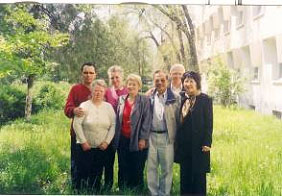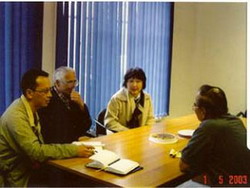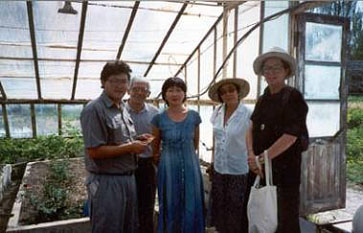Collaboration
- Details
- Category: Common
- Published on Wednesday, 22 April 2015 08:55
- Written by Super User
- Hits: 3866
Winrock International Institute for Agricultural Development



J. Juliano – US volunteer: right – in the Winrock office; left – with lab stuff; below – in the Biotechnology Institute’ mushroom enterprise


In the government residential’ subsidiary enterprise
Collaboration (2)
- Details
- Category: Common
- Published on Wednesday, 22 April 2015 08:55
- Written by Super User
- Hits: 940
Winrock International Institute for Agricultural Development



J. Juliano – US volunteer: right – in the Winrock office; left – with lab stuff; below – in the Biotechnology Institute’ mushroom enterprise


In the government residential’ subsidiary enterprise
Crops (2)
- Details
- Category: Common
- Published on Wednesday, 22 April 2015 08:47
- Written by Super User
- Hits: 960
Sugar beet being one the basic agricultural crops of Kyrgyzstan, during many years was the basic object of researches of laboratory. To this object are connected studying physiology-biochemical bases of immunity of plants to infectious diseases and development of biotechnological methods of protection of plants.
Potato and carnation. Works are connected to these objects on reception and micro-clonal propagation of improved virusless planting material of practically important plants species.
Cucumbers. Works are connected to this object on search of ecologically harmless methods of struggle against illnesses of plants and creation of the effective biological preparations protecting plants from illnesses, caused by pathogenic mushrooms. On materials of these researches recommendations on application of a preparation have been issued « on the basis of a Trichoderma lignorum mushroom for biological protection of cucumbers and sugar beet seed from root deceases.
Crops
- Details
- Category: Common
- Published on Wednesday, 22 April 2015 08:47
- Written by Super User
- Hits: 2762
Sugar beet being one the basic agricultural crops of Kyrgyzstan, during many years was the basic object of researches of laboratory. To this object are connected studying physiology-biochemical bases of immunity of plants to infectious diseases and development of biotechnological methods of protection of plants.
Potato and carnation. Works are connected to these objects on reception and micro-clonal propagation of improved virusless planting material of practically important plants species.
Cucumbers. Works are connected to this object on search of ecologically harmless methods of struggle against illnesses of plants and creation of the effective biological preparations protecting plants from illnesses, caused by pathogenic mushrooms. On materials of these researches recommendations on application of a preparation have been issued « on the basis of a Trichoderma lignorum mushroom for biological protection of cucumbers and sugar beet seed from root deceases.
Project #1
- Details
- Category: Common
- Published on Wednesday, 22 April 2015 08:38
- Written by Super User
- Hits: 4086
Physiological-biochemical researches of plant immunity. Working out of biotechnology methods of plant diseases resistant
The laboratory of plant physiology and biochemistry (former lab’s name) was one out of the six labs, which initially included during the organizing the Institute of Biochemistry and Physiology of the Kyrgyz Soviet Socialist Republic Academy of Science in 1964.
The research on the peculiarities of growth, development and general productivity of plants relevantly with photo-periods, water regime and mineral nutrition was conducted under his supervision.
There was a range of practical suggestions worked out; particularly, the method of defining demand of plants in water in accordance with transpiration indicator.
In the lab there was a research conducted on photosynthesis and sugar-accumulation of sugar beet, plant physiology in high-altitude mountainous areas, change in substance exchange of agriculture plants (tobacco, sugar beet, potatoes) caused by influence of parasite plants (zaraziha, dodder).
In 1980s the research on the working out physiological-biochemical basics of plant immunity to infection diseases has been begun. The research was conducted on mechanisms of steadiness of the sugar beet plants to root deceases relevant with the synthesis and collection of phytoalexines, phenolic compounds, lignin, phenolic metabolism’s exchange.
There was a group of populations of disease pathogen sorted out of the victimized sugar beet plants – pathogenic fungi. There was defined their internal difference in terms of morphological-physiological specifics. There were methods of defining the steadiness with biochemical markers worked out. There were mechanisms of plants’ steadiness to effect of certain chemical preparations worked out, the effectiveness of which is represented by ability to inactivate pathogenic factors of parasite fungi.
In 1990s the lab of plant physiology and biochemistry has begun research on mechanisms of steadiness of sugar beet to pathogenic fungi with use of tissue culture methods.
Double cultures were obtained – sugar beet with pathogenic fungi Rhizoctonia solani Kuehn. In healthy and contaminated tissues there was defined concentration of mono-and disaccharides, fenolic compounds, lignin, flavonoid phytoalexines, soluble proteins and their electrophoretic spectrums. The date obtained in result of research highlighted calluses as a steadily preserving organic and tissue specific, as well as metabolic profile, which the characteristic of initial tissue organ, from which it was obtained.
Knowledge of plant and micromycetes biochemistry and physiology, as well as tissue culture allowed putting the base under the further development of a brand new field – biotechnology of plants and micro- and macro mycetes.

